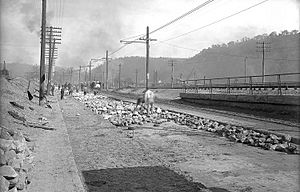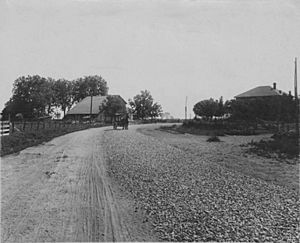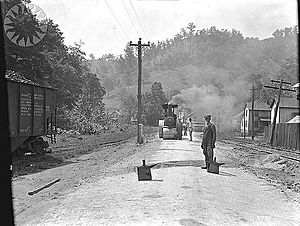Macadam facts for kids
Macadam is a special way of building roads. It was invented around 1820 by a Scottish engineer named John Loudon McAdam. His method uses layers of crushed stone that are pressed down very tightly. Sometimes, fine stone dust is added to help the stones stick together. Later, a sticky material like cement or tar was used to bind the stones even more, making the road stronger and less dusty. This new method made road building much simpler and better than older ways.
Contents
Early Road Builders
Pierre-Marie-Jérôme Trésaguet's Ideas
Pierre-Marie-Jérôme Trésaguet was a French engineer who helped bring new ideas to road building after the Roman Empire. He worked on roads in Paris in the mid-1700s. In 1775, he shared his ideas for building better and cheaper roads in France.
Trésaguet suggested building roads with three layers of stones. These layers were placed on a slightly curved base, with ditches on the sides to drain water away. The bottom two layers used hand-broken stones, about 3 inches (7.5 cm) big. The top layer was about 2 inches (5 cm) thick, with smaller stones around 1 inch (2.5 cm) in size. This top layer made the road smoother and protected the bigger stones underneath. He also made sure the road surface was higher in the middle than at the edges, which helped water run off.
Thomas Telford's Contributions
Thomas Telford was another important Scottish engineer. He built on Trésaguet's ideas but focused on using very good quality stone. He realized that using strong, cubical stone blocks could prevent many road problems.
Telford used large, partly shaped paving stones for the base, about 12x10x6 inches (30x25x15 cm). He placed these stones carefully, fitting them together like brickwork. Smaller broken stones were wedged into the gaps to make the layer very strong. On top of this strong base, he added a 6-inch (15 cm) layer of smaller stones. Finally, he covered the surface with a mix of gravel and broken stone. This way of building roads became known as "Telford pitching."
Telford also understood how important drainage was. He made sure roads were built above ground level whenever possible. If not, he dug ditches to drain water away from the road. This was a big improvement because many earlier road builders in Britain didn't pay enough attention to keeping roads dry.
The Macadam Revolution
John McAdam's Story
John Loudon McAdam was born in Scotland in 1756. He became very interested in roads and started working on them as a hobby. In 1802, he moved to Bristol, England, and became a Commissioner for Paving. By 1816, he was in charge of 149 miles of road in Bristol. This gave him the chance to try out his new ideas. The first road built using his "macadamised" method was Marsh Road in Bristol. He also wrote books about his road-building ideas, which became very popular.
How McAdam Built Roads
McAdam's method was simpler but very effective. He realized that you didn't need huge, heavy foundations of rock. He believed that the natural ground could support the road and traffic, as long as it was covered by a strong layer that protected the soil from water and wear.
Unlike other builders, McAdam laid his roads almost flat. His 30-foot (9-meter) wide roads only rose about 3 inches (7.5 cm) from the edges to the center. This slight curve, called "cambering," helped rainwater run off into ditches on the sides, keeping the road dry.
The size of the stones was very important to McAdam. The bottom 8 inches (20 cm) of the road used stones no bigger than 3 inches (7.5 cm). The top 2 inches (5 cm) layer used even smaller stones, about 0.8 inches (2 cm) across. Supervisors would even check the stone size with scales! Workers could also check if a stone would fit into their mouth to make sure it was small enough. These small stones were important because they were much smaller than the 4-inch (10 cm) wide iron wheels of carriages, making a smoother ride.
McAdam taught that stones should be broken by hand, using small hammers, so that no stone weighed more than 6 ounces (170 grams). He also said that the quality of the road depended on how carefully the stones were spread, one shovelful at a time.
He insisted that nothing that could soak up water and be damaged by frost should be put into the road. He also didn't use anything to bind the stones together at first. He believed that the traffic moving over the road would press the broken, angular stones together, making a strong, solid surface that could handle weather and traffic.
McAdam learned that a layer of broken, angular stones would act like one solid piece. This meant he didn't need the large, heavy stone layers that were used before. Keeping the surface stones smaller than the width of the wheels made a good, smooth surface for traffic.
First Macadam Roads in North America
The very first macadam road in the United States was built in 1823 between Hagerstown and Boonsboro, Maryland. Before this road, stagecoaches took 5 to 7 hours to travel this 10-mile (16 km) stretch in winter! This new road used McAdam's ideas, but it was compacted with a heavy cast iron roller instead of waiting for traffic to do the job. The second big American road built with McAdam's principles was the Cumberland Road, which was 73 miles (117 km) long and finished in 1830.
McAdam's Lasting Impact
McAdam became famous for his smart and affordable way of building roads. It was a huge improvement for his time. He showed that roads could be built for any kind of traffic, making travel much easier. His most important legacy is his focus on keeping roads well-maintained and managed. He believed there should be a central road authority with trained professionals who were paid well and responsible for their work.
Water-Bound Macadam
Other engineers started using McAdam's road-building ideas. One of them, Richard Lovell Edgeworth, found a way to make the roads even smoother. He filled the gaps between the surface stones with a mix of stone dust and water. This method is sometimes called water-bound macadam. Even though it needed a lot of manual work, it created a strong road that drained water well. Roads built this way were often called "macadamized."
Tar-Bound Macadam
When motor vehicles became popular, dust became a big problem on macadam roads. Fast-moving cars would suck dust right off the road surface, creating clouds of dust and slowly breaking down the road. To fix this, people started spraying tar on the surface to create tar-bound macadam. In 1902, a Swiss doctor named Ernest Guglielminetti thought of using tar from gasworks to bind the dust. Later, a mix of coal tar and ironworks slag, called tarmac, was invented.
Today, most roads use a more durable surface called asphalt pavement (sometimes called "blacktop" in the U.S.). Instead of laying stones and then spraying them with binder, the stones are mixed with the binding material first, and then the whole mixture is laid down. While most old macadam roads have been repaved, some parts of historic roads, like the National Road in the U.S., still show how they were built.
Because macadam was used for so long, roads in some parts of the United States (like Pennsylvania) are still sometimes called "macadam," even if they are actually made of asphalt or concrete. Similarly, the word "tarmac" is often used to talk about asphalt roads or airport runways.
See also






